It’s just a fact that compound bows aren’t as stable as rifles.. We archers don’t have the luxury of shooting prone, bipods, or shooting bags like our firearm-toting brethren. That is why any accessory that can help us squeak out more stability is greatly coveted.
A compound bow stabilizer not only gives stability to an unstable shooting process, but also for its secondary effects of improving accuracy, mitigating vibration, and making the act of shooting archery that much more enjoyable and comfortable.
What is a Compound Bow Stabilizer?
Shooting archery places us in an odd conundrum. We want to shoot light bows because it’s difficult to hold a heavy bow with our arms fully extended in front of us. Simultaneously, the lighter your bow is the more difficult it becomes to hold still for a precise and accurate shot.
A stabilizer does two things: it adds weight in just the right places to balance the bow, and it absorbs the shock initiated by the string release so that it doesn’t go into the limbs. It lets the bow remain light while adding much-needed stability and accuracy, as well as other benefits.
Best Stabilizer: Axion Archery Envy Pro
The Axion Archery Envy Pro rides on the same trend of a ventilated or air pass-through design as so many others which can be pivotal for hunters out in the field. Every little advantage helps. It also dons a unique “shark tooth” front face for maximum curb appeal with your archery cadre.
- CNC Machined Aluminum
- One Mathews® Harmonic Lite Damper
- Two Mathews® Flat Dampers
The Axion Archery Envy Pro stabilizer retails for $68.00 and is touted for “maximum vibration dampening and increased stabilization for noise reduction.” This stabilizer is slightly more expensive than previous ones mentioned, but it wins on its aesthetics and proprietary dampeners from Mathews®.
Best Economy Stabilizer: Trophy Ridge Static
The Trophy Ridge Static stabilizer from Bear Archery deploys some proprietary tech with their in-house Ballistix Co-Polymer System that affords you the strength of aluminum, but while being 25% lighter. This helps with vibration reduction and you get a soft touch Ballistix Coating as well on the exterior. At an MSRP of $29.99, this is a supremely affordable choice that is still mindfully designed.
- Includes two (2) customizable 1 ounce weights
- Unique design allows air to easily pass through for a steadier shot during windy conditions
“There is no other stabilizer out there quite like the Static Series Stabilizers from Trophy Ridge. The Static Stabilizer comes with customizable weights allowing you to control the weight and balance of the stabilizer depending on the situation. The Static Stabilizers also feature our popular Ballistix CoPolymer system which is 25% lighter than aluminum, but with the same strength. Serious stabilizers, for serious hunters.”
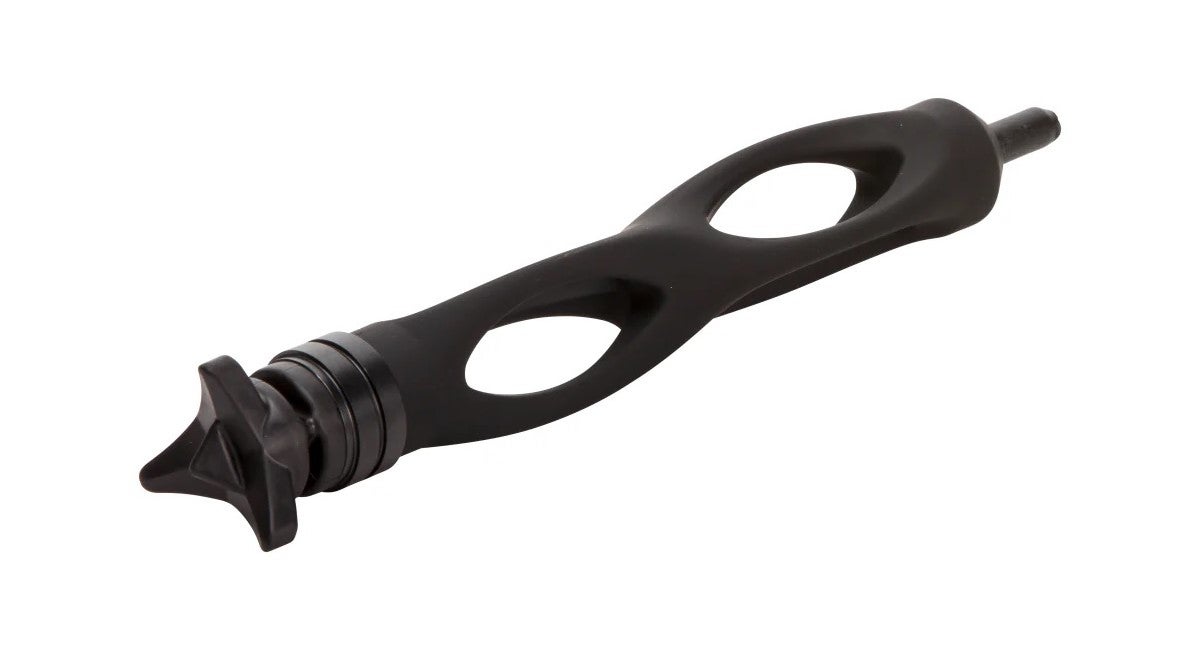
Best Premium Stabilizer: Bowtech Centermass
The Bowtech Centermass stabilizer is our most expensive suggestion with an MSRP of $119.95 to $149.95, but it could be the best offering, too. With the fusion of carbon fiber and aluminum, it is minimally light and still achieves desired vibration dampening.
- CenterMass Technology precisely aligns the accessory to optimize unmatched stability and accuracy in every shot.
- Optimized Dampener technology, specifically designed to minimize and virtually eliminate felt vibrations on the shot.
- Lightweight 1/2″ carbon rod ensures durability without compromising maneuverability.
- Available in multiple lengths: 6″ Bar, 8″ bar, 10″ bar, and 12″ bar. (Length of the carbon rod, dampener, and weights add an additional 2″).
Additionally, the Bowtech Centermass stabilizer comes with two independent 1 ounce weights so you can personalize your bow’s balance, fine-tune the noise reduction, and dampen that vibration.
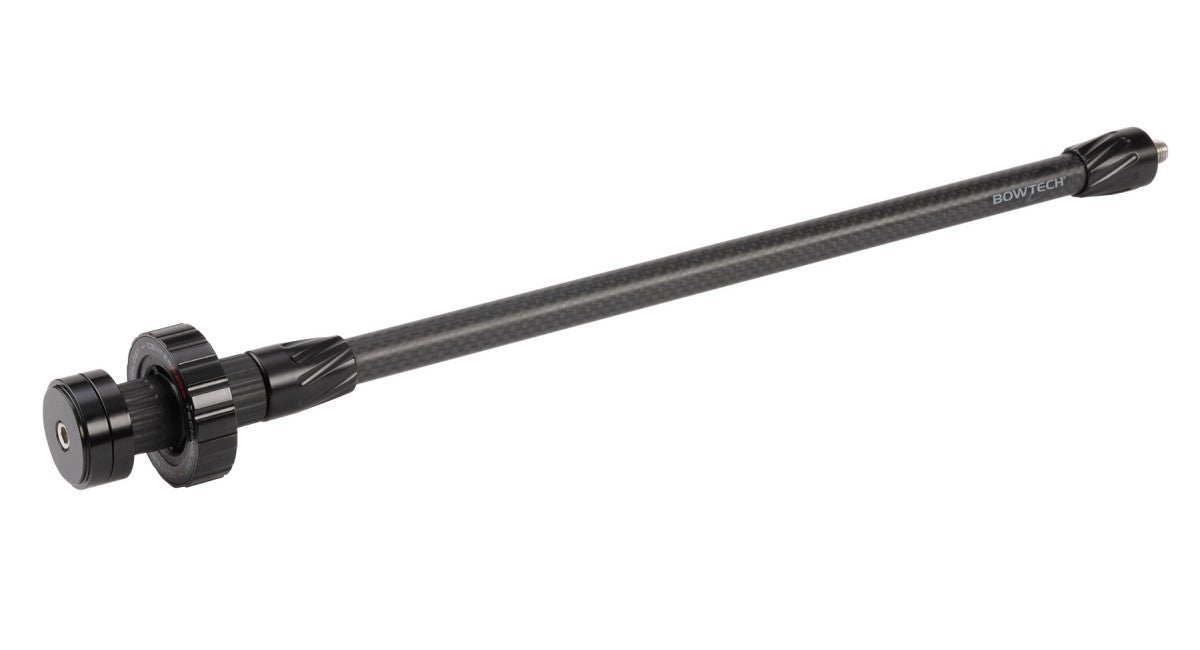
Why You Need a Stabilizer for Your Compound Bow
Improved Accuracy
Stabilizers do exactly as their name implies: they stabilize the bow. So, instead of our arms—and thus our bow sights—wandering everywhere while aiming our bow at a target because it is too light, we can have some stability that allows for more accurate shots.
Vibration and Noise Reduction
Stabilizers also give us the benefit of dampening the noise our bow makes when we shoot an arrow. The sound signature reduction can result in more successful harvests in the field. Have you ever heard of a whitetail deer “jumping” or ducking someone’s arrow before? An arrow is fast, but a deer’s reaction time can be faster. It has personally happened to me while hunting. If your bow is so loud that it sounds like clapping two 2x4s together, then you need a stabilizer to stifle those vibrations and dampen that noise.
Better Balance
Part of the battle of executing an accurate shot with your compound bow is not only holding the weight of your bow at arm’s length, but also balancing it. Bow manufacturers account for safety and accuracy in their bows. More often than not, they are not factoring in if it is balanced at full draw. A properly selected stabilizer can help balance out your bow so it is not front heavy or rear heavy; rather, it is just right.
Enhanced Comfort
A stabilizer can also afford us a pseudo placebo effect. If a bow is well balanced, quieter, and more accurate when compared to others, that gives us comfort, confidence, and peace of mind. All of those mental intangibles that can motivate us to shoot and practice more, get out hunting more often, and culminate in making us more successful from start to finish.
Types of Compound Bow Stabilizers
Front Stabilizers
Front bow stabilizers are the most common type of stabilizer. They typically attach near the handgrip of your compound bow and extend forward. They can be configured in an infinite amount of ways with dampening rubber material, carbon fiber, be short, long, and everything in between. However they are fashioned, their aim is still to stabilize you while shooting your bow.
Side and Rear Stabilizers
Side and rear stabilizers are usually not installed by themselves; rather, they are affixed to your bow in conjunction with a front stabilizer. It may come across as overkill, but for some target and competitive archers, by adding a front, side, and rear stabilizer, you have “all of your bases covered.” Think of it like metal stakes on a tent. You want to anchor all 4 corners so your tent doesn’t blow away. Similarly, you want to anchor your shooting position in all 4 corners so you aren’t wafting in the wind before you launch an arrow down range. This added balance and stability can be the difference between 1st and 10th place for some target archers.
Short vs. Long Stabilizers
A common trend people may see when they begin researching stabilizers is some are very short and compact while others are surprisingly long like they’re practically a sword. There is a method to the madness. Short stabilizers can still give us the benefits of dampening vibration, reducing noise, and improving accuracy all while being portable with a small footprint for hunting. Oppositely, if you opt for a long stabilizer, all of those positive attributes we previously mentioned are only magnified. Your bow will be more quiet, have fewer vibrations, and potentially be even more accurate. Long stabilizers are typically marketed toward target archers who have the space to use them (and have no fear of bonking into a tree limb).
Specialized Stabilizers
Specialized stabilizers are generally few and far between, but there are some out there. One such kind is a telescopic stabilizer. They offer less weight because of their ability to collapse, but they solve the predicament of having both length and portability. Other, more “common” specialized stabilizers are available for amputee or handicap archers.
Key Features to Consider When Choosing a Compound Bow Stabilizer
Length and Weight
When trying to decide the length and weight of stabilizer for your compound bow you need to account for two elements: What type of archery will you be doing (hunting or target shooting), and what type of physique/strength do you have?
For hunters, you are going to want a shorter, more compact stabilizer. This way you can be more maneuverable in a treestand, a blind, while saddle hunting, and slipping through brush on foot. This doesn’t mean you’re sacrificing the ability to have a heavier stabilizer, if you so desire. Compact stabilizers can still be as heavy as you like with lead weights and other materials incorporated.
For target shooters, you will likely want a longer stabilizer because it achieves greater balance, stability, and a better positioned fulcrum while aiming. With length you are not mandatorily also taking on weight. With lightweight materials, you can still achieve your preferred weight simply span across a greater distance in your stabilizer.
Finally, regardless of whether you are hunting or target shooting, you need to be brutally honest with yourself about how strong you are. Whether young or old, strong or weak, you need to know if you can have your bow at full draw for maybe 20 seconds or more with your desired stabilizer. If not, then you need to set your ego aside and figure out what you can manage.
Material
With the material that manufacturers and archers select, you need to not only account for the weight you want to achieve for yourself, but also how you shoot or hunt: how brutal are you on your gear? A carbon fiber or aluminum stabilizer might be feathery light like you want, but also susceptible to bending and breaking. Oppositely, I have had otherwise-durable steel stabilizers be frozen to the fabric of a bow case during a December hunt, and I had to rip my bow case to remove my frozen bow and stabilizer to get on with my hunt. The material of your stabilizer matters on many fronts.
Vibration Dampening
Stabilizers, in and of themselves, don’t do a ton to dampen vibrations. They’re primarily designed to solve the weight distribution equation. What is fantastic at dampening vibration during the launch of our arrows is rubber though. That is why you see rubber inserts in the cams of compound bows, sometimes in your bow’s string, and rubber is usually incorporated into our stabilizer somewhere. Every manufacturer will tout that their slurry of rubber is better than their competitors (it’s a lot of conjecture—some substantiated and others not), but one thing is certain, rubber in a stabilizer is terrific at reducing shock and noise.
Adjustability
There are adjustable stabilizers on the market that allow you to add and remove weights, or shorten and extend them as needed. The rationale for having one is so someone can easily switch from target shooting to hunting with a single stabilizer or vice versa. It’s incredibly rare for an adjustable stabilizer to be needed for a single discipline: only hunting, or only target shooting.
Price
You may see compound bow stabilizers anywhere from $20 all the way up to $150 or more. It all boils down to whether you have a budget or not, whether it is for target shooting or hunting, and how durable you want it to be.
Other Top Compound Bow Stabilizers
Bee Stinger Sport Hunter Xtreme Stabilizer
The Bee Stinger Sport Hunter Xtreme stabilizer is a good, economical, and simple choice for hunters who want a relatively compact option. With MSRPs varying from $64.99 to $89.99, it is affordable for the price conscious archers among us.
- Sizes: 6”, 8”, 10”
- Colorways: Matte Black, Mossy Oak Break-Up Country Camo
- Includes three (3) 1 ounce weights
The Sims Internal Harmonic Dampener and De-Resonator combine to subdue vibration transferred from the riser to the stabilizer when you shoot for a smooth shooting experience. Additionally, with three 1 ounce weights included, you can adjust the stabilizer exactly to your liking and needs.
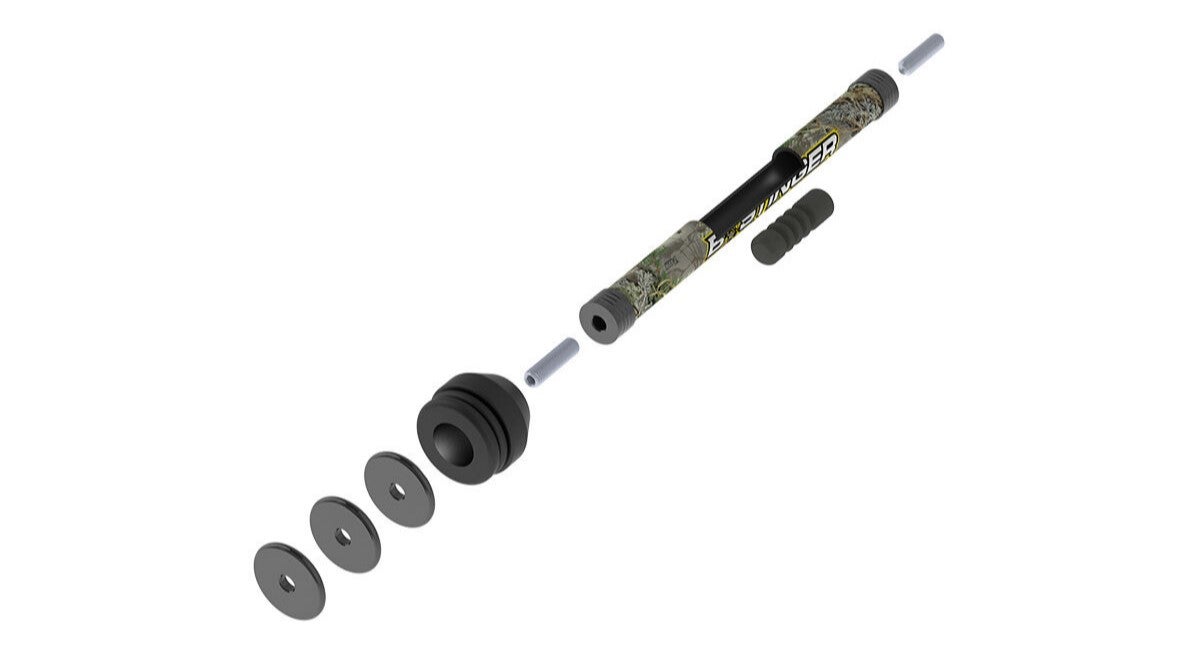
SAS Archery All-CNC Aluminum Stabilizer
This Southland Archery Supply (SAS) all-metal stabilizer is an interesting take on an age-old accessory. The SAS Archery All-CNC Aluminum stabilizer comes in 3 lengths and two color options of black or an in-house camo pattern.
- All CNC Aluminum Construction for Maximum Precision
- Extreme Vibration Dampening Technology for Max Vibration and Noise Reduction
- Full Draw Counterbalance
- Suitable for most recurve and compound bows
- Lightweight/Length: 5.3 oz (5”) | 6.5 oz (8”) | 10 oz (11”)
The straight-forward nature and improved steadiness on windy days with a pass-through design makes the SAS Archery All-CNC Aluminum stabilizer a great option for beginners. With pricing at $19.99 to $44.99, it is attainable as well.
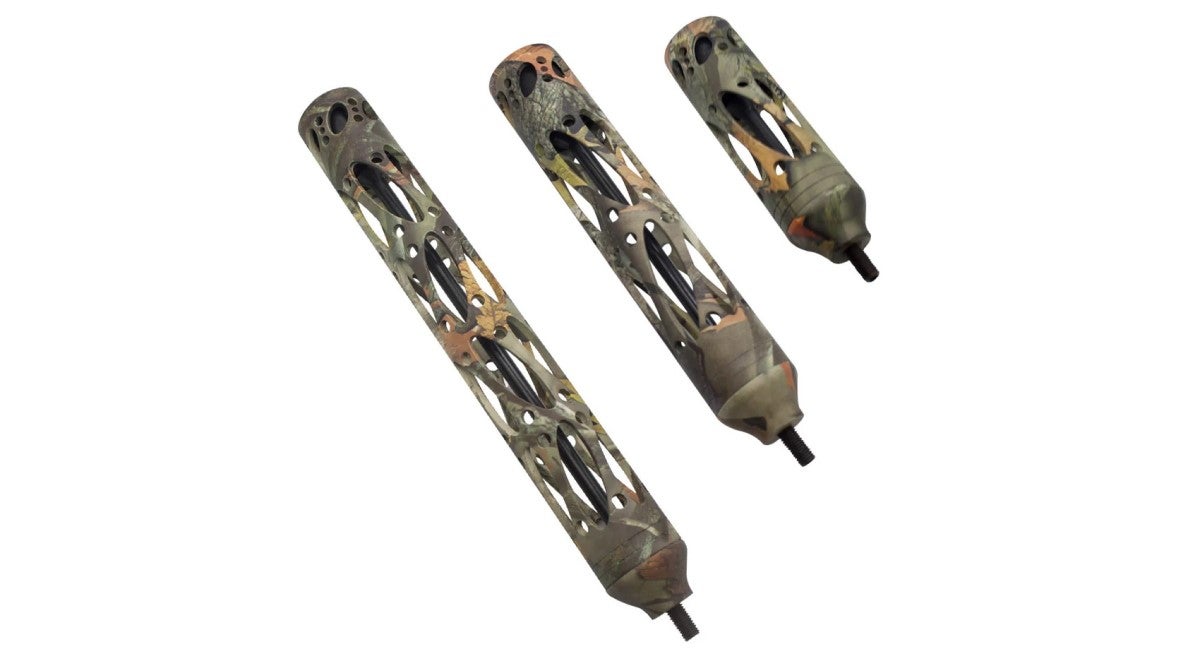
Hoyt Carbon Pro Stabilizer
The Hoyt Carbon Pro series of stabilizers offers you a lot of options and configurations to choose from. Not only in the length that you feel is appropriate for you, but also a bevy of camouflage options so your compound bow matches its stabilizer as well.
- Lengths: 6”, 8”, 10”
- Colorways: Blackout, Wilderness, Burbon, Buckskin, RealTree Edge, Kuiu Verde, Subalpine, Elevated 2, Kuiu Vias, Tombstone, Origin
The Hoyt Carbon Pro stabilizer has an MSRP of $89.99 to $99.99 with the 33 unique options you have available. With a melding of carbon fiber and metal, Hoyt touts these stabilizers as being “designed to crush vibration on the shot, making your bow even quieter and smoother.”
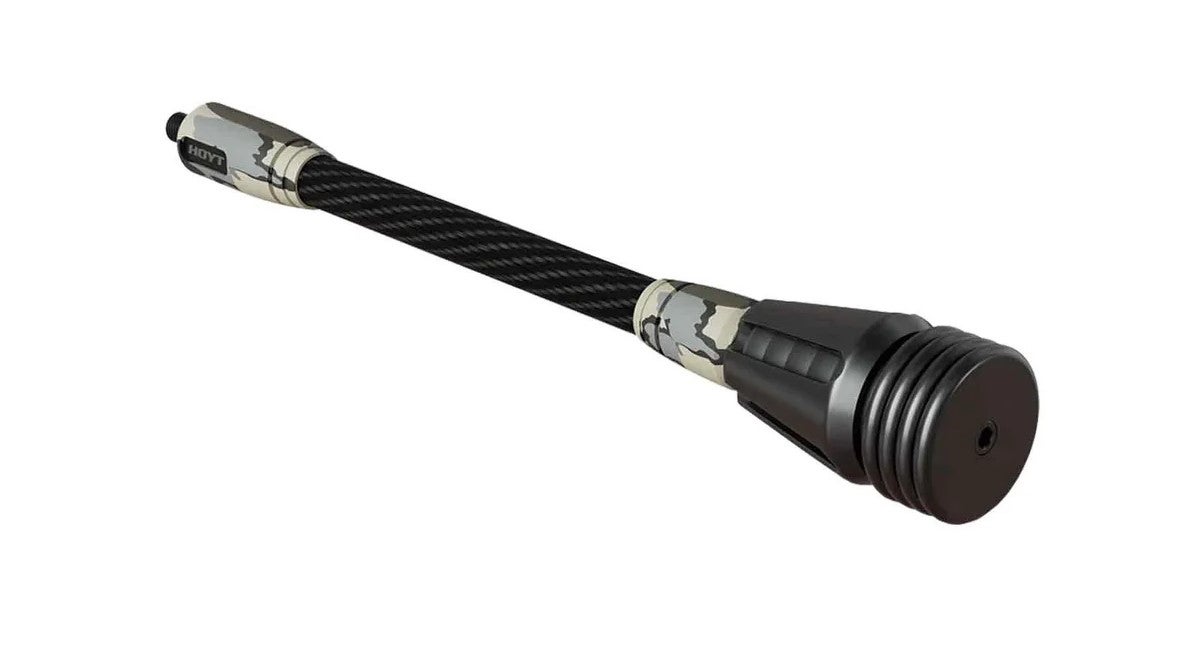
How to Choose the Best Stabilizer for Your Needs
Make sure that you are matching your stabilizer to your specific needs. Hunting stabilizers are going to have different desirable attributes than those used by target archers and vice versa. So, don’t buy the hype that your bros are selling you. Invest in a stabilizer that is suited for how you use your compound bow.
Speaking of investing, don’t be afraid to buy a couple of stabilizers. One you might find handy for practicing in the backyard. Another might be good for mountainous game hunting. If you’re looking for an ultimate do-all stabilizer, you will be sorely disappointed. Moreover, stabilizers in the grand scheme of things aren’t so expensive that you couldn’t afford a few to try out. One might be perfect for hunting from a treestand, another for long-range target shooting, and a third could be great for stalking game over great distances.
How to Install and Adjust a Compound Bow Stabilizer
The easy part about adding, removing, and changing your bow’s stabilizer is most all modern, compound bows have a universally threaded location near the bow’s grip to hand screw in a stabilizer. No tricky mounting solutions. Simply thread it on by hand and be on your way. The only exceptions are when you get into odd stabilizers like rearward and side facing models or extremely specialized ones. For the bulk of archers, a front facing stabilizer is the way to go.

With your stabilizer, it is desirable to achieve a good balance. That coveted balance is where the bow—while in your hand—feels like it has no need to fall rearward (towards you) or fall forward (away from you). A perfectly balanced bow is not always achievable based on your stature, the bow, your strength, and innumerable other factors, but it is always the goal.
Many of our picks have adjustable and removable weights. This can assist in your pursuit of customizing your stabilizer in hopes of achieving that perfect balance.
Common Mistakes to Avoid
Choosing the Wrong Length/Weight
If you choose an inappropriate length and weight stabilizer for your compound bow, it can actually exacerbate the noise and vibrations that your bow makes. It is no different than adding improper modifications to your car. “The wheels will fall off quickly” when you start adding things willy-nilly without making methodical choices.
Overlooking Compatibility
We discussed why hunters and target shooters want certain stabilizer types. If you simply run out and purchase one because “it looks cool” or “your friend has one so you want one, too” it can lead to poor performance—inaccuracy, too heavy, unbalanced, loud—real quickly. So, choose a stabilizer that is suited for your style and intended use.
Neglecting Practice
Familiarity is important. Just like you shouldn’t add a new bow sight without practicing before a hunt or competition nor should you add a stabilizer without testing it and becoming familiar with its balance, weight, and feel.
FAQs About Compound Bow Stabilizers
“Can I use a stabilizer for both hunting and target shooting?”
Yes, but only on rare occasions. If you happen to invest in an adjustable or telescopic stabilizer, you might be able to use it for both hunting and target shooting. The best solution if you can swing it financially is to get dedicated ones for each.
“How long should my stabilizer be?”
This is dictated by many factors like your draw length, how strong you are (can you support that weight at full draw), does it impede my field-use (hunting vs target shooting), etc. The most important thing you are looking to achieve with a stabilizer is balance. Don’t forsake balance for a stabilizer that’s long enough to touch the target itself.
“What is the ideal weight for a stabilizer?”
Classic lawyer response: it depends. Again, you need to factor in how strong you are, if you are achieving your desired balance point or not, and what is the form factor of the stabilizer: is it long, short, does it have rubber for greater vibration dampening, etc.
Conclusion
We will reiterate that a stabilizer is meant to accomplish several things for you: reduce noise, curb vibrations, improve accuracy, and make for a more pleasurable shooting experience. Make sure to carefully select a stabilizer that suits your needs and to practice regularly to maximize your stabilizer’s inherent benefits. A quality stabilizer is a small investment to greatly improve your overall archery performance. Remember that shooting archery off-hand is an inherently unstable act. A stabilizer should bring you balance, stability, and peace of mind.
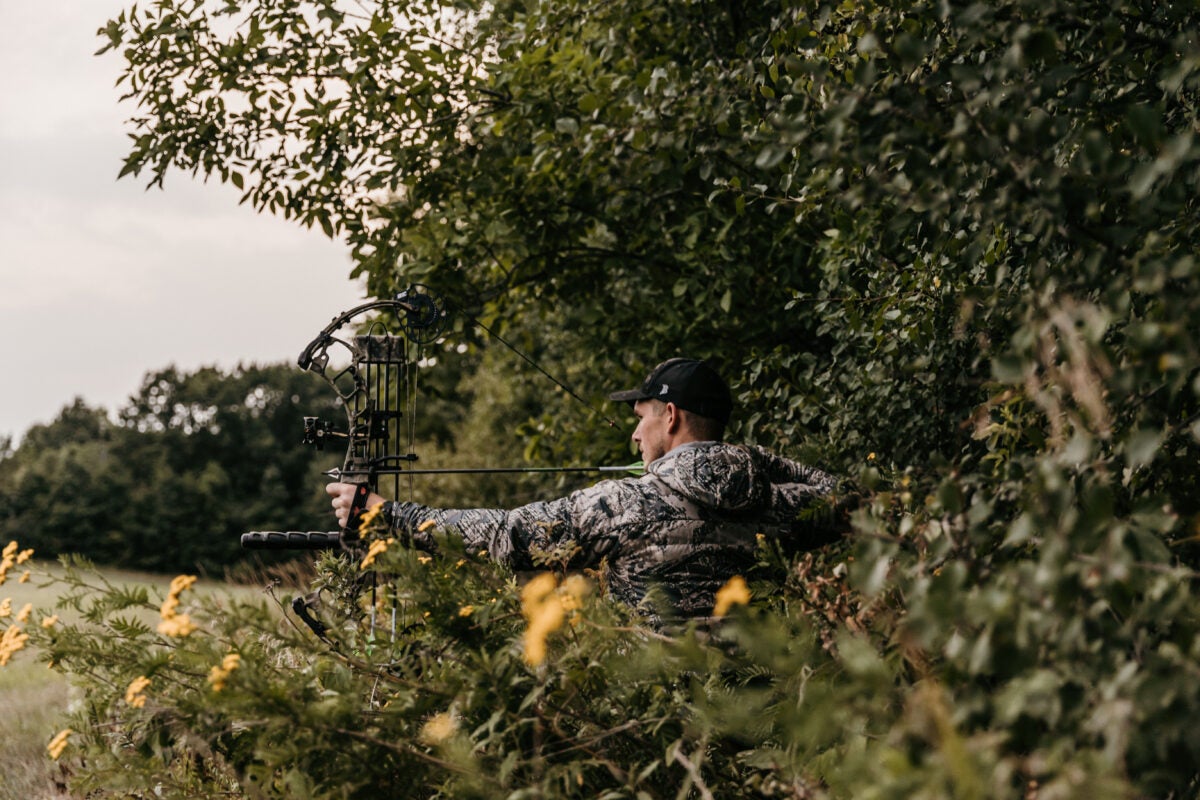
The post The Best Compound Bow Stabilizer Guide for 2025 appeared first on AllOutdoor.com.
